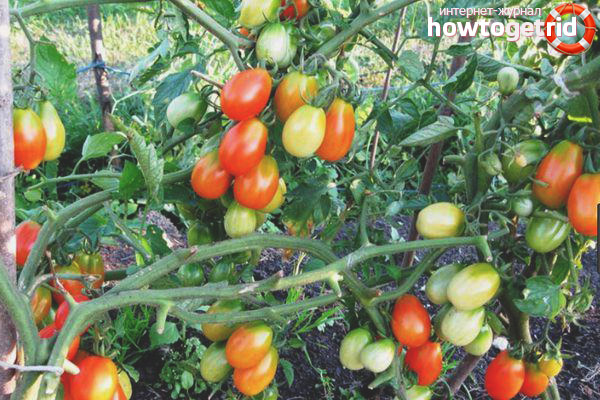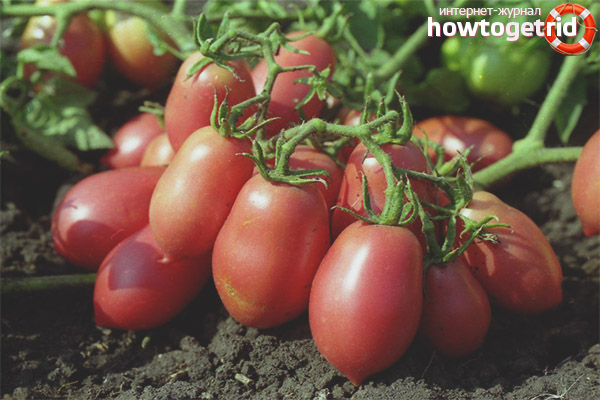The content of the article
A variety of medium or medium early ripening time, indeterminate in nature of growth. These plants are adapted for growing in greenhouses and temporary shelters.
Characteristic
Most growers believe that the first crop can be harvested 4 months after sowing seeds. In height, the plant grows to a maximum of 1.5 m. The first flower brush is formed over 7-9 leaves, later on through 3 leaves. In one brush there can be from 7 to 9 fruits.
Description of the fruit: have a red color, elongated shape. Their mass is from 150 to 200 g. The pulp is fleshy, has an excellent taste.
Advantages
- The fruits are universal in use.
- The shape is unusual.
- Plants are undemanding to care.
- Bushes of this variety are resistant to temperature extremes.
- Good immunity to many diseases.
- Fruits are resistant to cracking.
- High transportability and keeping quality of fruits.
- You can use the fruits both in fresh form and for processing.
Growing recommendations
- Seeds for seedlings should be sown 50-60 days before planting at the fruiting site. If possible, containers with sown seeds should be kept at a temperature of 24-25 degrees.
- Landing in a permanent place should be in such a way that to 1 square. meter accounted for 3 plants.
- Bushes must be tied to trellises or stakes.
- Plants of this variety are considered to be well responsive to irrigation and top dressing. Watering is usually recommended approximately once a week.
Top dressing
It is also necessary to feed regularly, but it is believed that bell bushes are enough to be fed 3-4 times a season. Such a multiplicity of top dressing is possible only with good dressing of planting holes and in soils with a high level of fertility. In order for the plants to do without fertilizing, for example, before the flowering period of 3 flower brushes, it is advisable to add at least one fertilizer with a long-lasting effect to the wells. Most of them are organic (humus, biohumus) and organomineral (WMD). Mineral fertilizers also come with a long-lasting effect. The most famous and common of them is the AVA station wagon.
Those gardeners who are rarely in the city can recommend the introduction of humus with a small amount of superphosphate. After flowering the third flower brush in many areas, tomato plants may need to be fed. In such cases, you can use as some organic fertilizers, for example, tinctures of manure or herbs, extracts from vermicompost, and mineral, such as Zdorov, Mortar, Fertika. These fertilizers contain a large list of nutrients selected in physiologically reasonable proportions.
Plant protection

Bell tomatoes have a natural resistance to disease. However, with massive outbreaks and a large number of infections, they can also be affected by some fungal diseases, in particular late blight, cladosporiosis, macrosporiosis. To prevent infection, it is advisable to triple prophylactic spraying with biological products, such as Alirin-B, Bactofit, improving the soil by spilling a suspension of biofungicides such as Trichoderma viride, Sporobacterin, as well as the above funds.
As a potent disinfectant, it is permissible to use a Pharmaiod solution.To increase their resistance to fungal infections, it is advisable to use immunomodulators (Immunocytophyte, Narcissus, Ecogel, humates, Silk, NV-101, microfertilizers (Uniflor-micro, Aquadon-micro, Orbigum, Siliplant), biological products of the EM series (Baikal EM1, Vostok .
In case of symptoms of cladosporiosis (brown plaque) or late blight, the fungal spread can be somewhat controlled by fungicides such as Ordan, Profit, 1% Bordeaux mixture. In addition to fungicides to suppress fungi, Pharmaiod helps to some extent in a concentration of 2 ml / 1 liter of water.
Pests
The opinion of gardeners about the variety
The experience of gardeners shows that the fruits usually grow not large, for example, weighing 105 grams, that is, only single fruits reach a mass of 150 grams. At the same time, some gardeners admit that the fruits do not crack, and the taste is noticeable sweetness. At the same time, due to the large number of fruits, the productivity of tomato bellflower is considered by many to be normal.
Video: Tomato Care - The First Important Steps










Submit